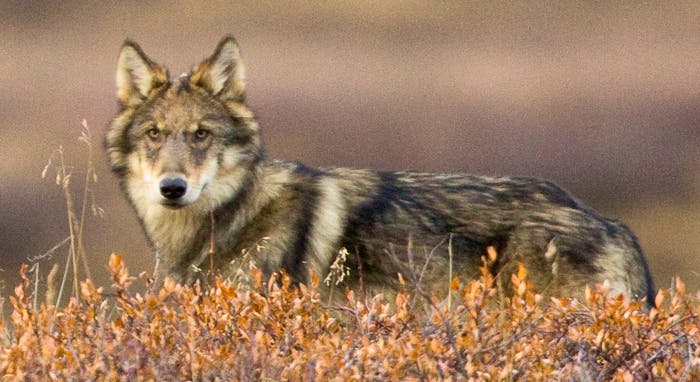The state of Alaska is pursuing aggressive predator control measures on our national wildlife refuges, targeting bears, wolves and other wildlife on land that was meant for their conservation.
Alaska is a state unlike any other, home to diverse landscapes from the tundra of the high arctic to temperate rainforests in the south. Polar bears, wolves, and brown bears live here. In many parts of the state, these carnivores live in pristine habitat as they have for thousands of years, hunting their natural prey, including moose, caribou, deer, salmon and more.
Congress has passed multiple laws – including the Alaska National Interest Lands Conservation Act and the National Wildlife Refuge System Improvement Act – to ensure that the U.S. Fish and Wildlife Service (FWS) manages wildlife in its natural diversity on national wildlife refuges across the state. That is, the explicit purpose of Alaska’s refuges is to support balanced, healthy wildlife populations and their habitat. Even animals that some may see as inconvenient – like large carnivores – must be protected because they have a natural place in the ecosystem. Here in Alaska, that applies to 16 national wildlife refuges covering more than 76 million acres of wildlife habitat. In those places, native carnivores are accepted, even welcomed. Step one paw outside of any protected lands, however, and that’s a very different story.
 In 1994, Alaska adopted an intensive “predator control” policy designed to dramatically reduce the number of wolves, bears and other native carnivores on the land so that more prey animals – mainly moose and caribou – are available for game hunters. In recent years, the state has greatly expanded the reach of this effort, and now allows more aggressive predator control in more locations than ever before. The program authorizes extreme non-subsistence hunting practices for bears, wolves and other iconic carnivores, including trapping, baiting, aerial gunning and even killing mothers and their young.
In 1994, Alaska adopted an intensive “predator control” policy designed to dramatically reduce the number of wolves, bears and other native carnivores on the land so that more prey animals – mainly moose and caribou – are available for game hunters. In recent years, the state has greatly expanded the reach of this effort, and now allows more aggressive predator control in more locations than ever before. The program authorizes extreme non-subsistence hunting practices for bears, wolves and other iconic carnivores, including trapping, baiting, aerial gunning and even killing mothers and their young.
The policy has clear and severe impacts on our wildlife. On the Kenai Peninsula near the state’s main population center, two years of state-sanctioned brown bear baiting resulted in a kill rate six times higher than the previous 50-year average, and Kenai brown bear populations dropped 18 percent.
Alaska’s program is inappropriate for wildlife management anywhere. But on national wildlife refuges, it is unthinkable.
FWS has opposed specific predator control measures on individual refuges in the past, in order to preserve the purpose of those lands. In January, they zolpidem online took a stronger stand, proposing a rule that would ban the use of these targeted killing methods on all 16 national wildlife refuges in Alaska. The new rule will help conserve native carnivores on these public lands, and ensure that our national wildlife refuges are managed for all wildlife. The rule promotes wildlife conservation by barring the following non-subsistence hunting practices on national wildlife refuges across the state:
- Killing wolves, coyotes and their pups during the spring and summer “denning’ season
- Shooting mother bears and their cubs
- Trapping and snaring brown bears and black bears
- Baiting brown bears
- Aerial gunning of bears by state agency personnel
Unfortunately, the proposed rule and the protections it would afford to these iconic American wildlife on Alaska refuges is under attack in Congress. The House has already passed the so-called “Sportsmen’s Heritage and Recreation Enhancement (SHARE) Act” with a rider that blocks finalization of the rule and withdraws the National Park Service’s authority to put similar protections in place for native carnivores on Alaska national preserves. The House passed the same rider again as part of a massive, unrelated energy bill, which may soon be under consideration in the Senate. And a Senate version of the sportsmen’s bill also includes the same rider that would prevent the rule from moving forward.
What a mess. Thankfully, we are not too late to address these legislative attacks on this much needed regulation. We are working with our conservation allies in Congress to make sure that this egregious rider never becomes law.
Wolves, brown bears and other carnivores play a critical role in the ecosystem. They keep populations of other species healthy, and they help prevent problems like overgrazing and disease in herds of wild deer, moose and caribou. These charismatic carnivores attract tourists to national parks and refuges, and enrich the national imagination. They are essential to the American landscape in Alaska and within the Lower 48. We must fight to protect wildlife on national wildlife refuges, both for our benefit and for future generations.
This blog is part of an ongoing series on our National Wildlife Refuge system and the vital role that refuges play in protecting species and providing crucial habitat for wildlife. Check in regularly to hear from our field teams, policy experts and staff on Capitol Hill about new developments and continuing threats to these wild places and what you can do to help.



